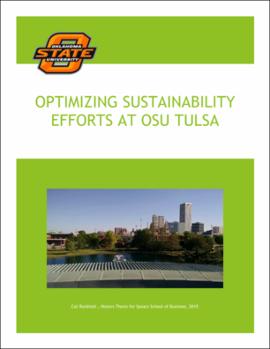| dc.description.abstract | A study and comparison in the different recycling trends impacting colleges today. In particular, comparing OSU Tulsa to OSU Stillwater, TU, NSU, and TCC. The study reveals a missed opportunity for the OSU Tulsa campus to implement a comprehensive recycling program on campus to bring it in-line with surrounding schools. Studies show students are factoring in how green a campus is as part of their overall decision criteria for choosing a campus. Having a visible comprehensive program adds to the legitimacy of the campus. In addition, students care about any and all sustainable efforts their school is making, and want to know about such efforts. OSU implemented a fantastically successful system wide behavior based energy conservation program that regularly adds an average of $300K per month of monetary value to its overall bottom line. Of this $300K, the OSU Tulsa campus regularly contributes approx. 10% or $30K per month to this program. Despite these successes, very few students are aware of this success or knew the campus has a Sustainability department at all. This is a missed opportunity to capture additional tuition revenue by attracting new and retaining existing green minded students. Something as simple as having a clear visible recycling program sends a non-verbal message to students that the OSU Tulsa campus is a "real" college campus. Visiting students cannot see the quality of instructors, the heartbeat of campus life, or the ability to participate in the same programs, awards, etc. the Stillwater campus offers, but they can see recycling bins. Although this may seem insignificant, this paper proves the fallacy of such logic. Students should be able to see a recycling program that is at least equal to or better of other schools, including its own parent campus in Stillwater. While students may not be able to verbally vocalize what is off about the Tulsa campus, seeing inconsistency in the existing recycling programs, especially after seeing higher quality programs at community colleges, such as TCC, diminishes the appeal of choosing the OSU Tulsa campus. As part of this paper, a detailed cost analysis is explored with the recommendation of reallocating energy conservation savings to pay for the purchase of new bins. The proposed bins would pay for themselves with just the attraction of 5 new students or one month of the existing energy program savings. | |
